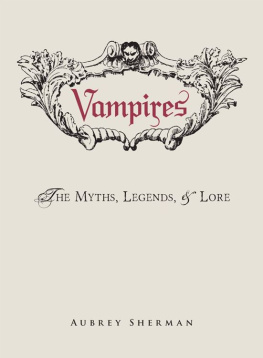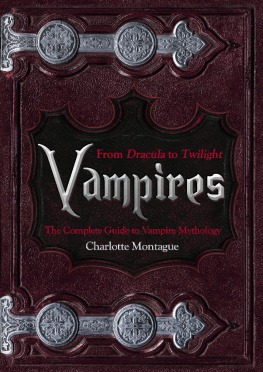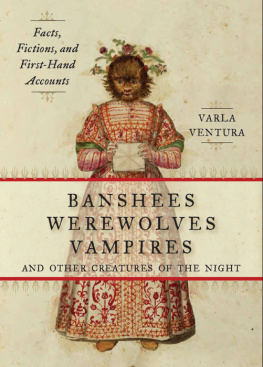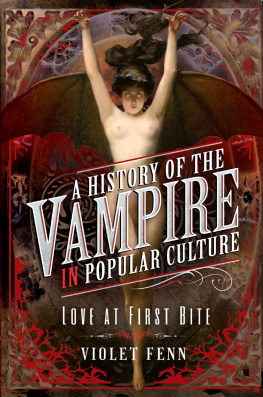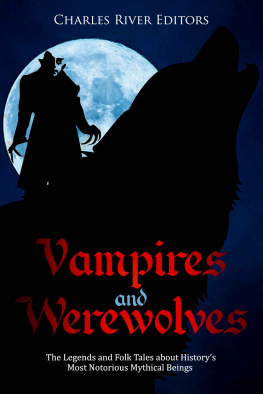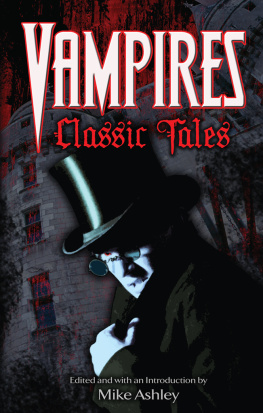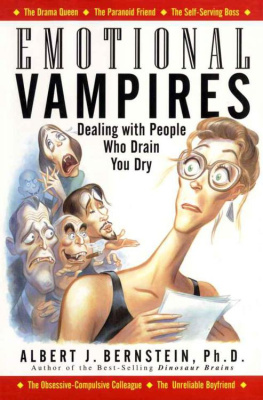Vampires
THE MYTHS, LEGENDS, & LORE
AUBREY SHERMAN

Avon, Massachusetts
Contents
INTRODUCTION
IN THE SHADOWS of our imagination lurk the creatures of the night. Tall, bone-thin, possessed of an exotic, frightening beauty, their eyes glow with a red spark that holds you fast while sharp white teeth champ against ruby lips and then sink into your flesh.
Vampires have been our dark companions in literature and art, myth, and religion from the early centuries of civilization. But during the past 150 years, more than any other legendary figure the vampire has been romanticized and eroticized.
For many people, vampires represent the dichotomous relationship between love and death, between eros and thanatos. Even as you understand that vampires can only survive by drawing on the blood of the living, it is this very act that attracts you to them.

Le Vampire, lithograph by R. de Moraine, 1864
Why is the legend of the vampire so attractive? Perhaps because it mirrors human absorption with the phenomenon of deathvampires, after all, are suspended between life and death; they are what Bram Stoker, author of Dracula, famously referred to as the undead. From this shrouded world they hold forth the promise of eternal life, albeit at a terrible price. Or maybe they interest us because vampires are drawn to our blood, and blood is the essence of our existence; as Renfield, Draculas minion, puts it, The blood is the life.
Today vampires more often inspire lust than repulsionwhether its the sparkly Edward Cullen of Stephenie Meyers Twilight saga; the brooding Bill Compton and Eric Northman, the male vampires at the heart of Charlaine Harriss Sookie Stackhouse stories; or Angel, the tormented vampire and one-time lover of Buffy the Vampire Slayer. Vampires also play an influential role in a subculture: goths, who dress in black, sport multiple body piercings, and find their muse in the fiction of Anne Rice and Poppy Z. Brite.
As you explore the myths and legends of vampires in the pages of this book, you will come to better understand these mysterious, powerful, dangerous, exotic creatures and may even find the roots of your own fascination with them.
PART 1
THE HISTORY OF VAMPIRES
CHAPTER 1
The Origins of Vampires
I am glad that [the house] is old and big. I myself am of an old family.
C OUNT D RACULA , D RACULA BY B RAM S TOKER
THROUGHOUT THE CENTURIES and in dozens of cultures, vampires remain a centerpiece of the darker sides of lore and mythology, and our current passion for night terrors shows no signs of waning. Part of that fascination may be attributed to our fervent hope that there is life after death. If there is ongoing life in the spiritual world, is it really a leap of faith to believe that there may well be life after death that exists in the underbelly of our own world?
LIVE LONG AND PROSPER
Any research of vampires or vampirism throughout history inevitably leads to the genesis of the bloodsucker as we know it todayBram Stokers seminal 1897 novel, Dracula. While much of the praise for Dracula is deserved, it must be noted that there exists a much richer history surrounding the legends of what are commonly referred to as revenantsindividuals who return from the dead. Like the revered Greek and Egyptian gods of mythology, there are numerous legends, superstitions, and beliefs highlighting a dark contingent of vampiric creatures that tour the underworld, and play on our most primal fears. Given that most vampire folklore rarely uses the word vampire, how has the traditional vampire evolved from these stories of the undead?
INCUBI AND SUCCUBI
The incubus of ancient folklore was believed to be a male demon who forced unwanted sexual relations on a sleeping woman. In female form, the demon is known as a succubus. Both apparitions are often linked to early European vampiric entities, including the German alp and the Hungarian lidrc. Even Brazil has its own form of incubus, the boto, which seduces women and leads them to the river. Of course, the incubus made for a handyand plausibleexcuse for unwanted pregnancies.

Tales of vampiric revenants vary greatly depending on their country of origin, their subsequent incarnation, and which folklorist or historian is telling of their exploits. The majority of creatures now cited as vampires or vampiric in nature are typically human and/or animal hybrids, zombielike beasts, and birth demons.
HOW VAMPIRES ARE CREATED
The most obvious answer to this question is that a vampire becomes a member of the undead through the bite of another vampire. While in the majority of cases that may hold true, a vampires making is infinitely more complicated, depending on the type of vampire and whether the demon is a beast of legend, mythology, literature, or film. Some outer-space suckers, for example, draw out a humans energy by mouth-to-mouth contact rather than biting.
THE ORIGIN OF VAMPIRE
The term vampire wasnt typically used in folklore but first appeared in English references in the late 1600s. Author Katherine Ramsland notes that a description of vampires as reanimated corpses appeared in 1810, in Travels of Three English Gentlemen, from Venice to Hamburg, Being the Grand Tour of Germany, in the Year 1734.
Throughout folklore there are many varied references to the ways in which an individual could become a vampire. Candidates for the undead include children born out of wedlock, those who lead sinful or criminal lives or commit suicide, women who allow vampires to gaze upon them, and even the seventh son of a seventh son. But thats just the tip of the iceberg. Depending on the culture and its superstitions and beliefs, vampires might also be those who are born with teeth or who, like witches, possess a third nipple. Individuals who are not baptized or who are born on holy days are also at risk, as are those who practice black magic, or who die violently.
The Maker as Parent
If you are seduced by a vampire, he becomes your maker, or parent. One thing that most vampires have to learn is how much blood to take from a victim. Taken in small doses, the blood of a victim can sustain a vampire for quite some time before she or he dies or, should the vampire choose, enters the world of the undead. The act of consuming blood is for the vampire a matter of restraint, as the action generally triggers sexual arousal and a frenzy that if not carefully controlled kills the victim.
Depending on the type of vampire, bringing or crossing over a victimthat is to say, making him or her a vampirecan have various consequences. Some new vampires gain the memories of their maker, while others are left to discover their powers and bloodlust for themselves. In Anne Rices Interview with the Vampire, Louis tells of his making by Lestats hand in 1791, describing being weak to paralysis, in complete panic, and possessing the inability to speak. Once initiated with Lestats blood, Louis roams free, seeing the world for the first time with preternatural eyes.

